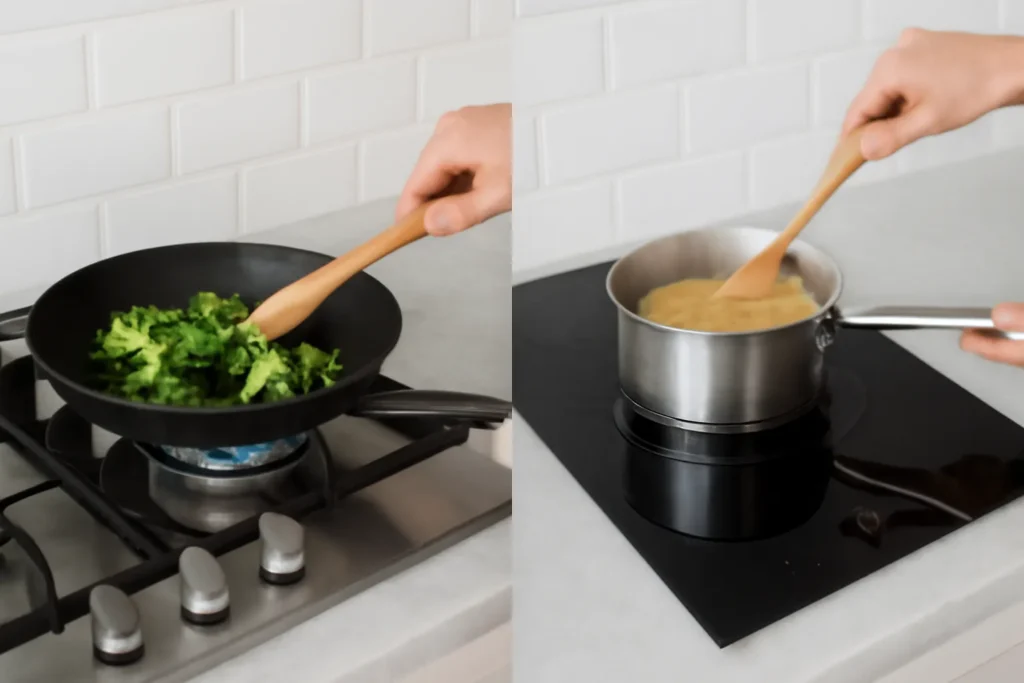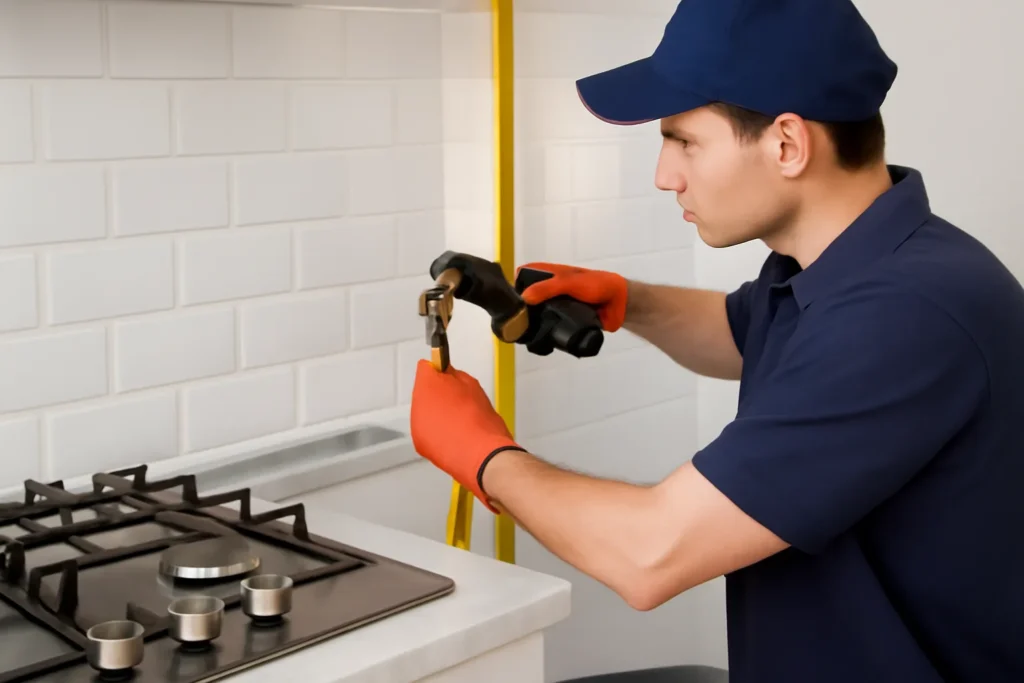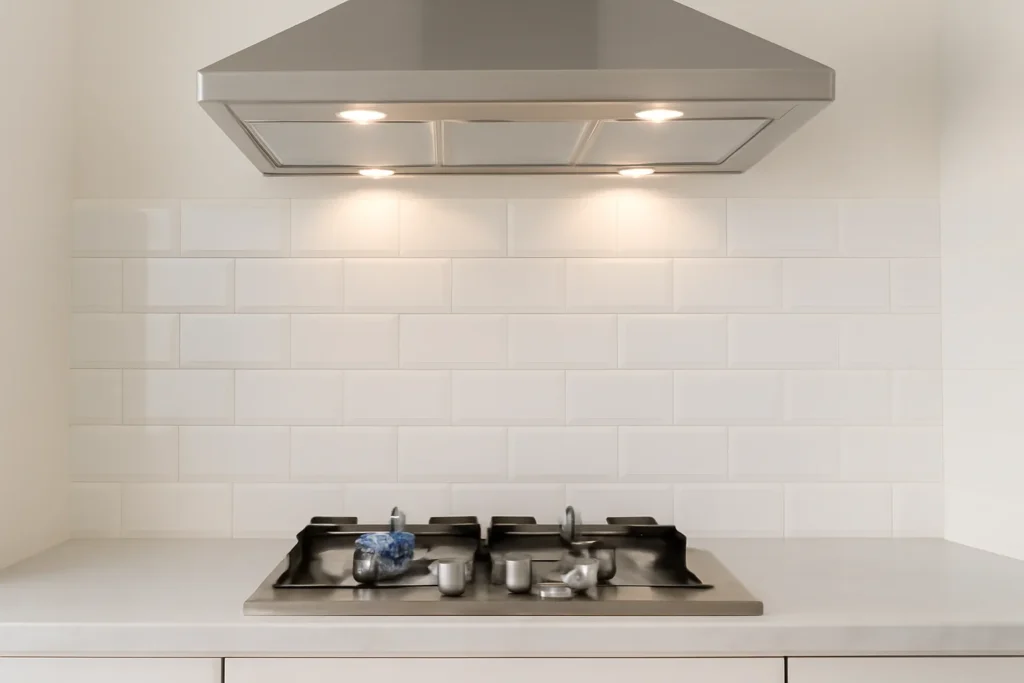Which is better, gas or electric? It seems like a simple choice until you’re standing in an appliance store, trying to decide what works best for your home.
Do you want the instant flame of gas or the sleek control of an electric cooktop? What about costs, efficiency, and installation?
This guide will cover all of that. We’ll walk you through the basics, including energy costs, setup, and how each option works day to day, to help you decide.
Let’s start with performance and see how gas and electric cooking compare.
Gas vs. Electric Cooking: Performance, Power and Precision

There’s no perfect answer that suits everyone when it comes to choosing between gas and electric. What works great for your neighbour might not fit your cooking habits or budget at all. That being said, knowing how gas stoves and electric stoves actually work can help you pick what’s right for your home.
Here’s what you’ll notice when you start cooking.
How Cooking Feels Different
Gas stoves give you something that electric models just can’t match. You can actually see the flame, which makes it easy to tell exactly how hot things are getting. That instant heat change is perfect for things like stir-frying, where you need quick control.
Electric stoves work in a completely different way, but they have their own advantages. That flat surface gives you really steady, even heat that works brilliantly for slow cooking or when you’re making delicate sauces. Many people who love baking actually prefer electric ovens because they keep the same temperature much better.
Cookware Compatibility and Technique
Cast iron pans and woks absolutely love gas burners because of that direct flame. You get much better heat spread around curved surfaces, which really matters if you’re into traditional cooking techniques or want that perfect sear on your steak.
Electric stoves work great with most pans, but they perform best when you’re using flat-bottomed cookware. Their smooth surface makes it super easy to move pots around, and you don’t need to worry about flames affecting your pan’s finish over time.
Where Induction Fits In
Now here’s something that confuses lots of people: induction isn’t actually a separate type of stove. It’s more like the premium version of electric cooking that uses magnetic fields to heat your pans directly.
This gives you precise control while using less power, and it’s perfect for tasks like simmer a delicate sauce or sear a steak fast.
Next, let’s look at the cost and setup needed for your Brisbane home.
Kitchen Upgrades in Brisbane: Costs, Installation, and Infrastructure Tips

Money always matters when you’re doing up your kitchen, and there are quite a few other costs that can sneak up on you if you’re not prepared.
You might need new gas connections, better electrical wiring, or even council permits, depending on what your house currently has.
We’ll walk you through everything you should plan for so there are no unpleasant surprises down the track.
Appliance Costs and Budget Planning
Gas stoves usually cost less to buy than electric ones. You can get a decent gas appliance starting around $800, while a similar electric model often starts closer to $1,200.
As you go up to fancier models, the price difference gets smaller. High-end gas and electric stoves from good brands end up costing about the same, usually somewhere between $2,000 and $4,000, depending on what features you want.
Installation and Home Compatibility
Now, having natural gas already connected to your house makes a massive difference to what you’ll pay for installation. But if there’s no gas connection yet, you’ll need professionals to run new pipes through your house. This job can add anywhere from $500 to $1,500 to your total project cost.
Electric stoves need the right electrical setup too, and in older houses, that often means upgrading the wiring to handle powerful appliances safely. This is especially true if you’re thinking about induction cooktops, which use quite a bit of power.
Running Costs in Brisbane
If you’re worried about your monthly bills, we recommend using gas appliances. Natural gas simply costs less to produce the same amount of heat, so monthly savings are likely compared to electricity. But, electric stoves don’t waste as much heat, so the difference isn’t huge.
Though electric stoves can push your electricity bills higher in summer, gas stoves usually keep energy costs steady all year.
Don’t Forget the Hidden Expenses
There are always extra costs that catch people off guard. For starters, you’ll need installation permits, professional labour, and proper ventilation systems. And if you’re switching to induction, you might also need new pots and pans since they only work with magnetic-compatible cookware.
Your choice also affects how safe your kitchen feels, how it looks, and how well it fits with your daily routine.
Kitchen Safety and Design: What to Consider for Gas and Electric Stoves

A kitchen is also where the family meets, friends join for parties, and you spend much of your day. So it’s only natural to worry about gas leaks or electrical problems.
The reality is that both gas stoves and electric stoves have their own safety things to think about, but you can handle them pretty easily with the right setup and a bit of common sense.
Take a look at these few considerations before making your choice.
What’s Safer for Your Space?
Firstly, gas stoves do have those open flames, which means you need to watch out for things like loose clothing or tea towels getting too close to the burners. There’s also a small chance of gas leaks, though modern appliances come with really good safety features these days.
Electric stoves have their own things to be careful about. The cooking surface stays hot for quite a while after you switch it off, which can catch people by surprise. You might also have electrical issues, but that’s pretty rare if you get quality appliances and have them installed properly.
So both types are actually quite safe when you follow basic safety rules and keep your appliances in good condition.
Air Quality and Ventilation Requirements
Now, did you know gas stoves create indoor air pollution while they’re burning? That’s why proper ventilation is important. You’ll want a decent range hood that actually pushes air outside your house.
Electric stoves don’t make those combustion gases, but you still need ventilation to deal with cooking smoke and steam from your food.
Either way, you’ll want a quality vent hood to keep things comfortable.
Which Suits Your Cooking Life?
Busy families often love gas stoves because they heat up really fast and cool down quickly too, so dinner prep becomes much quicker and easier. Weekend cooks who like trying new recipes also appreciate having that instant control over the heat levels.
But, if you live in an apartment, electric might be easier since most buildings already have the electrical setup sorted out. Also, it’s great for anyone who cooks often and enjoys slow cooking or baking, as an electric keeps the heat steady.
Style and Layout: What Looks Best in Brisbane Kitchens?
Finally, when it comes to style and layout, it really comes down to your personal taste.
Electric cooktops (especially the induction ones) give you that clean, modern look that works perfectly in contemporary Brisbane kitchens. That smooth surface fits beautifully with current design trends and makes cleaning really easy.
Gas stoves bring more of a traditional or industrial feel that suits classic kitchen styles really well. Those visible burners and metal grates add some character that lots of homeowners absolutely love having in their space.
Which Stove Is Best for Your Kitchen?
So, after weighing up all the performance differences, costs, and lifestyle factors, how do you actually make this decision? The answer depends on your specific situation, budget, and what matters most to your household.
You can use this quick checklist to make your choice easier:
- Do I already have natural gas installed?
- What’s my cooking style: high-heat or low-and-slow?
- Am I planning to resell soon?
- Am I redesigning or upgrading partially?
- What rebates or regulations apply in QLD?
But you don’t actually have to pick just one type for your whole kitchen. Dual fuel setups let you have an electric oven for consistent baking plus a gas cooktop for quick, responsive cooking. Many professional chefs actually prefer this setup because it gives you the best of both worlds.
If you’re ready to make your choice, head over to Blue Olive appliances to see both gas and electric models up close.
Our team can help you compare specific features, chat about installation requirements, and find the perfect appliance for your Brisbane kitchen project.
